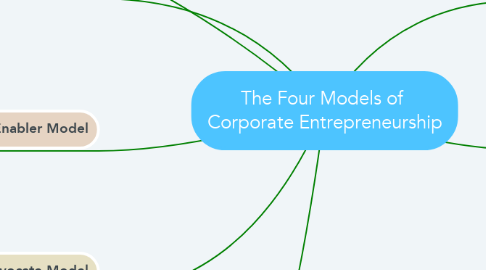
1. The Opportunist
1.1. Without any designated organizational ownership or resources, corporate entrepreneurship proceeds based on the efforts of intrepid “project champions”
1.1.1. Project champions
1.1.1.1. People who toil against the odds, creating new businesses often in spite of the corporation
2. The Enabler Model
2.1. Employees across an organization will be willing to develop new concepts if they are given adequate support
2.2. Enables teams to pursue opportunities on their own insofar as they fit the organization’s strategic frame.
3. The Advocate Model
3.1. A company assigns organizational ownership for the creation of new businesses while intentionally providing only modest budgets to the core group.
3.1.1. Advocate organizations act as evangelists and innovation experts, facilitating corporate entrepreneurship in conjunction with business units.
4. The Producer Model
4.1. Entrepreneurship by establishing and supporting formal organizations with significant dedicated funds or active influence over business-unit funding
5. Selecting The Right Model
5.1. Point the way
5.1.1. Articulate a strategic vision for growth
5.2. Delineate objectives
5.2.1. Start with a small team to clearly define and communicate the company’s objectives
5.3. Neutralize the naysayers
5.3.1. Build corporate and divisional leadership consensus through extensive communication
5.4. Select and support a corporate entrepreneurship model.
5.5. Start with quick wins
5.5.1. build credibility with tangible performance and to learn lessons to protect programs
5.6. Evolve
5.6.1. Successful corporate entrepreneurship requires adaptation in order to generate self-sustaining new businesses
6. Emprendimiento corporativo
6.1. the process by which teams within an established company conceive, foster, launch and manage a new business that is distinct from the parent company but leverages the parent’s assets, market position, capabilities or other resources
7. Four Models
7.1. the opportunist
7.1.1. diffused ownership and ad hoc resource allocation
7.2. the enabler
7.2.1. diffused ownership and dedicated resources
7.3. the advocate
7.3.1. focused ownership and ad hoc resource allocation
7.4. the producer
7.4.1. focused ownership and dedicated resources
